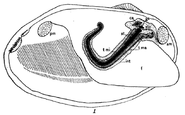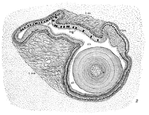Rotating locomotion in living systems
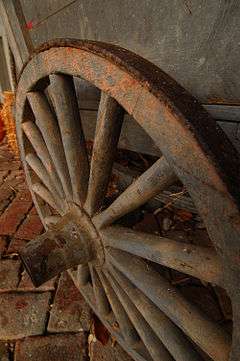
There exist two distinct modes of locomotion using rotation: first, simple rolling; and second, the use of wheels or propellers, which spin on an axle or shaft, relative to a fixed body. Several organisms are capable of rolling. True wheels and propellers, however, despite their utility in human vehicles, do not appear to play a significant role in the movement of living things (with the notable exception of certain flagella, which function like corkscrews). Biologists have expounded on the reasons for this apparent absence of biological wheels, and wheeled creatures have appeared often in speculative fiction.
Given the ubiquity of the wheel in human technology, and the existence of biological analogues of many other technologies (such as wings and lenses), the lack of wheels in the natural world would seem to demand explanation—and the phenomenon is broadly explained by two main factors. First, there are several developmental and evolutionary obstacles to the advent of a wheel by natural selection—addressing the question "Why can't life evolve wheels?". Secondly, wheels are often at a competitive disadvantage when compared with other means of propulsion (such as walking, running, or slithering) in natural environments—addressing the question "If wheels could evolve, why would they be rare nonetheless?". Incidentally, this environment-specific disadvantage also explains why some historical civilizations have abandoned wheels.
Known instances of rotation in biology
Rolling
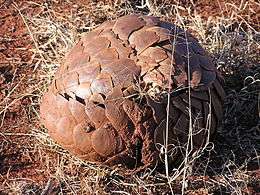
Some organisms use rolling as a means of locomotion. These examples do not constitute the use of a wheel, as the organism rotates as a whole, rather than employing separate parts which rotate independently.[1][2]
Several species of elongate organisms will form their bodies into a loop in order to roll, including certain caterpillars, tiger beetle larvae, myriapods, mantis shrimp, and Mount Lyell salamanders.[1][3][4] Other species adopt more spherical postures, primarily for defense, which may allow rolling; this behavior has been observed in pangolins, hedgehogs, armadillos, Armadillo girdled lizards, isopods, wheel spiders, and fossilized trilobites.[4][5] These species may roll passively (under the influence of gravity or wind) or actively, typically by altering their shape to generate a propulsive force.[4]
Tumbleweeds are the above-ground portions of certain plants, which separate from their root structure and roll in the wind to distribute their seeds.
Dung beetles form spherical balls of animal excrement, which they roll with their bodies. Although it is the dung ball that rolls rather than the beetle itself, the beetles face many of the same mechanical difficulties that rolling organisms contend with.[4]
Keratinocytes, a type of skin cell, migrate with a rolling motion during the process of wound healing.[6][7]
Rotifers, although their Latin name means "wheel-bearer", do not have any rotating structures, but rather a ring of rhythmically beating cilia used for feeding and propulsion.[8]
Free rotation
Macroscopic
Among animals, there exists a single known example of an apparently freely-rotating structure, though it is not propulsive: the crystalline style of certain bivalves and gastropods. The style consists of a transparent glycoprotein rod which is continuously formed in a cilia-lined sac and extends into the stomach. The cilia rotate the rod, so that it becomes wrapped in strands of mucus. As the rod slowly dissolves in the stomach, it releases digestive enzymes.[9] Estimates of the speed of rotation of the style in vivo vary significantly, and it is unclear if the style is rotated continuously or intermittently.[10]
Molecular
There are two known examples of molecular-scale rotating structures used by living cells.[11] ATP synthase is an enzyme used in the process of energy storage and transfer, notably in photosynthesis and oxidative phosphorylation.[12] It bears some similarity to the flagellar motors discussed below.[13] The evolution of ATP synthase is thought to be an example of modular evolution, in which two subunits with their own functions have become associated and gained a new functionality.[14]
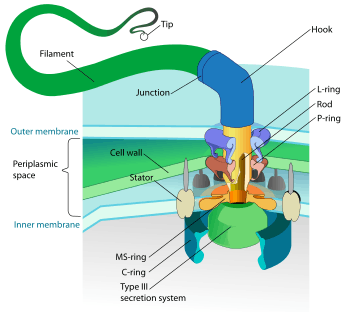
The only known example of a biological "wheel"—a system capable of providing continuous propulsive torque about a fixed body—is the flagellum, a corkscrew-like tail used by single-celled prokaryotes for propulsion.[15]:396 The bacterial flagellum is the best known example.[16][17] About half of all known bacteria have at least one flagellum, indicating that rotation may in fact be the most common form of locomotion in living systems, though its use is restricted to the microscopic environment.[18]
At the base of the bacterial flagellum, where it enters the cell membrane, a motor protein acts as a rotary engine. The engine is powered by proton motive force, i.e., by the flow of protons (hydrogen ions) across the bacterial cell membrane due to a concentration gradient set up by the cell's metabolism. (In species of the genus Vibrio, there are two kinds of flagella, lateral and polar, and some are driven by a sodium ion pump rather than a proton pump.[19]) Flagella are quite efficient, allowing bacteria to move at speeds of up to 60 cell lengths per second. The rotary motor at the base of the flagellum is similar in structure to ATP synthase.[11] Spirillum bacteria have helical bodies with flagella at either end, and they spin about the central axis of their bodies as they move through the water.[20]
Archaea, a group of prokaryotes separate from bacteria, also feature flagella driven by rotary motor proteins, which are structurally and evolutionarily distinct from bacterial flagella. Whereas bacterial flagella evolved from the bacterial Type III secretion system, archaeal flagella appear to have evolved from Type IV pili.[21]
Some eukaryotic cells, such as the protist Euglena, also have flagella, but eukaryotic flagella do not rotate at the base; rather, they bend in such a way that the tip of the flagellum whips in a circle. The eukaryotic flagellum, also called a cilium or undulipodium, is structurally and evolutionarily distinct from prokaryotic flagella.[22]
Biological barriers to wheeled organisms
Evolutionary constraints
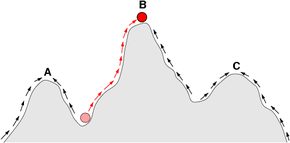
The processes of evolution, as they are presently understood, can help explain why wheeled locomotion has not evolved in multicellular organisms: simply put, a complex structure or system will not evolve if its incomplete form provides no benefit to the organism.[23]
According to the modern evolutionary synthesis, adaptations are produced incrementally through natural selection, so major genetic changes will usually spread within populations only if they do not decrease the fitness of individuals.[23] Although neutral changes (ones which provide no benefit) can spread through genetic drift,[24] and detrimental changes can spread under some circumstances,[25]:728–729 large changes that require multiple steps will occur only if the intermediate stages increase fitness. Richard Dawkins describes the matter: "The wheel may be one of those cases where the engineering solution can be seen in plain view, yet be unattainable in evolution because it lies [on] the other side of a deep valley, cutting unbridgeably across the massif of Mount Improbable."[23] In such a fitness landscape, wheels might sit on a highly favorable "peak", but the valley around that peak may be too deep or wide for the gene pool to migrate across by genetic drift or natural selection. Stephen Jay Gould notes that biological adaptation is limited to working with available components, commenting that "wheels work well, but animals are debarred from building them by structural constraints inherited as an evolutionary legacy."[26]:48
Natural selection therefore explains why wheels are an unlikely solution to the problem of locomotion—a partially evolved wheel, missing one or more of its key components, would probably not impart an advantage to an organism. The exception to this is the flagellum, the only known example of a freely rotating propulsive system in biology; in the evolution of flagella, individual components were recruited from older structures, where they performed tasks unrelated to propulsion. The basal body that is now the rotary motor, for instance, might have evolved from a structure used by the bacterium to inject toxins into other cells.[27][28][29] This recruitment of previously evolved structures to serve new functions is called exaptation.[30]
Molecular biologist Robin Holliday has written that the absence of biological wheels argues against creationist or intelligent design accounts of the diversity of life, because an intelligent creator—free of the limitations imposed by evolution—would be expected to deploy wheels wherever they would be of use.[31]
Developmental and anatomical constraints
| Wikibooks has a book on the topic of: Biomechanics |
Using human manufacturing processes, wheeled systems of varying complexity have proven fairly simple to construct, and issues of power transmission and friction have proven tractable. It is not clear, however, that the vastly different processes of embryonic development are suited to—or even capable of—producing a functioning wheel, for reasons described below.[Note 1]
The greatest anatomical impediment to wheeled multicellular organisms is the interface between the static and rotating components of the wheel. In either a passive or driven case, the wheel (and possibly axle) must be able to rotate freely relative to the rest of the machine or organism.[Note 2] Unlike animal joints, which have a limited range of motion, a wheel must be able to rotate through an arbitrary angle without ever needing to be "unwound". As such, a wheel cannot be permanently attached to the axle or shaft about which it rotates (or, if the axle and wheel are fixed together, the axle cannot be affixed to the rest of the machine or organism).[26]:44 There are several functional problems created by this requirement that may prove to be intractable.
Power transmission to driven wheels
.jpg)
In the case of a driven wheel, a torque must be applied to generate the locomotive force. In human technology, this torque is generally provided by a motor, of which there are many types, including electric, piston-driven, turbine-driven, pneumatic, and hydraulic. (Torque may also be provided by human power, as in the case of a bicycle.) In animals, motion is typically achieved by the use of skeletal muscles, which derive their energy from the metabolism of nutrients from food.[15]:406 Because these muscles are attached to both of the components that must move relative to each other, they are not capable of directly driving a wheel. In addition, large animals cannot produce high accelerations, as relative inertia increases rapidly with body size.[32]
Friction
In typical mechanical systems, some type of bearing and/or lubricant must be used to reduce friction at the interface between two components. Reducing friction is vital for minimizing wear on components and preventing overheating. As the relative speed of the components rises, and as the contact force between them increases, the importance of friction mitigation increases as well. In biological joints such as the human knee, friction is reduced by means of cartilage with a very low friction coefficient, as well as lubricating synovial fluid, which has very low viscosity. Gerhard Scholtz, professor at the Institut für Biologie Vergleichende Zoologie ("Institute for Biology and Comparative Zoology") at Humboldt University of Berlin, asserts that a similar secreted lubricant or dead cellular material could allow a biological wheel to rotate freely.[4]
Nutrient and waste transfer
Another potential problem that arises at the interface between wheel and axle (or axle and body) is the ability of an organism to transfer materials across this interface. If the tissues that make up a wheel are living, they will need to be supplied with oxygen and nutrients and have wastes removed in order to sustain metabolism. A typical animal circulatory system, composed of blood vessels, would not be able to provide transportation across the interface.[23][15]:405 In the absence of circulation, oxygen and nutrients would need to diffuse across the interface, a process that would be greatly limited by the available partial pressure and surface area, in accordance with Fick's law of diffusion.[26]:48 For large multicellular animals, diffusion would be insufficient.[16] Alternately, a wheel could be composed of excreted, nonliving material such as keratin, of which hair and nails are composed.[4][16]
Disadvantages of wheels
Wheels incur mechanical and other disadvantages in certain environments and situations that would represent a decreased fitness when compared with limbed locomotion.[23] These disadvantages suggest that, even barring the biological constraints discussed above, the absence of wheels in multicellular life may not in fact be the "missed opportunity" of biology that it first seems. On the contrary, given the mechanical disadvantages and restricted usefulness of wheels when compared with limbs, the central question can be reversed: not "Why doesn't nature produce wheels?", but rather, "Why don't human vehicles make more use of limbs?"[16] The use of wheels rather than limbs in many engineered vehicles can likely be attributed to the complexity of design required to construct and control limbs, rather than to a consistent functional advantage of wheels over limbs.[33][34]
Efficiency
Rolling resistance
Although stiff wheels are more energy efficient than other means of locomotion when traveling over hard, level terrain (such as paved roads), wheels are not especially efficient on soft terrain such as soils, because they are vulnerable to rolling resistance. In rolling resistance, a vehicle loses energy to the deformation of its wheels and the surface on which they are rolling. Smaller wheels are especially susceptible to rolling resistance.[15]:401 Softer surfaces deform more and recover less than firm surfaces, resulting in greater resistance. Rolling resistance on medium to hard soil can be five to eight times greater than on concrete, and resistance on sand can be ten to fifteen times greater.[16] While wheels must deform the surface along their entire path, limbs induce only a small, localized deformation at the point of foot contact.
Rolling resistance is also the reason wheels are not seen in certain historical human civilizations.[16] During the time of the Roman Empire, wheeled chariots were common in the Middle East and North Africa; yet when the Empire collapsed and its roads fell into disrepair, wheels fell out of favor with the local populations, who turned to camels to transport goods in the sandy desert climate. In his book Hen's Teeth and Horse's Toes, Stephen Jay Gould explains this curiosity of history, asserting that, in the absence of maintained roads, camels required less manpower and water than a cart pulled by oxen.[35]
Efficiency of aquatic locomotion
When moving through a fluid, rotating systems carry an efficiency advantage only at extremely low Reynolds numbers (i.e., viscosity-dominated flows) such as those experienced by bacterial flagella, whereas oscillating systems have the advantage at higher (inertia-dominated) Reynolds numbers. Whereas ship propellers typically have efficiencies around 60% and aircraft propellers up to around 80% (achieving 88% in the human-powered Gossamer Condor), much higher efficiencies, in the range of 96%–98%, can be achieved with an oscillating flexible foil like a fish tail or bird wing.[15]:398[16]
Traction
Wheels are prone to slipping—an inability to generate traction—on loose or slippery terrain. Slipping wastes energy and can potentially lead to a loss of control or becoming stuck, as with an automobile on mud or snow. This limitation of wheels can be seen in the realm of human technology: in an example of biologically inspired engineering, legged vehicles find use in the logging industry, where they allow access to terrain more challenging than what wheeled vehicles can navigate.[36] Tracked vehicles suffer less from slipping than wheeled vehicles, owing to their larger contact area with the ground—but they tend to have larger turning radii than wheeled vehicles, and they are less efficient and more mechanically complex.[37]
Obstacle navigation

Work by engineer Mieczysław G. Bekker implies that the distribution of irregularities in natural terrains is log-normal; i.e., small obstacles are far more common than larger ones. Thus, obstacle navigation presents a challenge to wheeled locomotion in natural terrains at all size scales.[15]:400–401 The primary means of obstacle navigation are to go around obstacles and to go over them; each has its attendant challenges.
Going around obstacles
Anatomist Michael LaBarbera of the University of Chicago illustrates the poor maneuverability of wheels by comparing the turning radii of walking and wheelchair-bound humans.[15]:402 As Jared Diamond points out, most biological examples of rolling are found in wide open, hard packed terrain, including the use of rolling by dung beetles and tumbleweeds.[16]
Going over obstacles
Wheels are poor at dealing with vertical obstacles, especially obstacles on the same scale as the wheel itself. Assuming a vehicle or animal can shift its center of mass, the limiting height of vertical obstacles for a passive wheel is equal to the radius of the wheel.[16] If the center of mass cannot be shifted, the highest obstacle a vehicle can surmount is one quarter to one half the radius of the wheel. Because of these limitations, wheels intended for rough terrain require a larger diameter.[15]:400
In addition, without articulation, a wheeled vehicle can become stuck on top of an obstacle, with the obstacle between the wheels, preventing them from contacting the ground.[38] Limbs, in contrast, are useful for climbing and are equipped to deal with uneven terrain.[15]:402–403
With unarticulated wheels, climbing obstacles will cause the body of a vehicle to tilt. If the vehicle's center of mass moves outside of the wheelbase or axle track, the vehicle will become statically unstable and tip over.[39] At high speeds, a vehicle can become dynamically unstable, meaning that it can be tipped over by an obstacle smaller than its static stability limit, or by excessive acceleration or tight turning.[40] Without articulation, this can be an impossible position from which to recover.
Versatility
Limbs used by animals for locomotion over terrain are frequently also used for other purposes, such as grasping, manipulating, climbing, branch-swinging, swimming, digging, jumping, throwing, kicking, and grooming. With a lack of articulation, wheels would not be as useful as limbs in these roles.[15]:399
Rolling and wheeled creatures in fiction and legend
Legends and speculative fiction reveal a longstanding human fascination with rolling and wheeled creatures.
Rolling creatures

The hoop snake is a creature of legend in the United States and Australia.[3] The snake is said to grasp its tail in its mouth and roll like a wheel towards its prey. The Japanese Tsuchinoko is a similar mythical creature.[41]
Buer, a demon mentioned in the 16th-century grimoire Pseudomonarchia Daemonum, was described in Collin de Plancy's 1825 edition of Dictionnaire Infernal as having "the shape of a star or wheel".[42] The 1863 edition of this book featured an illustration by Louis Le Breton, depicting a creature with five legs radially arranged.[43]
The 1944 science fiction short story "Arena", by Fredric Brown, features a telepathic alien called an Outsider, which is roughly spherical and moves by rolling.[44] The story was the basis for a 1967 Star Trek episode of the same name and possibly also a 1964 episode of The Outer Limits entitled "Fun and Games", though neither television treatment included a spherical creature.[45]
The Dutch graphic artist M. C. Escher invented a creature that he named Pedalternorotandomovens centroculatus articulosus, which was capable of rolling itself forward. He illustrated this creature in his 1951 lithograph Wentelteefje (also known by the English title Curl-up).[4][46]
A 1956 Scrooge McDuck comic by Carl Barks, Land Beneath the Ground!, introduced Terries and Fermies (a play on the phrase terra firma), creatures who move from place to place by rolling. The Terries and Fermies have made a sport of their rolling abilities, causing earthquakes in the process.[47][48][49]
Tuf Voyaging, a 1986 science fiction novel by George R. R. Martin, features an alien called a Rolleram, described as a "berserk living cannonball of enormous size", which kills its prey by rolling over it and crushing it, before digesting it externally. Adults of the species weigh approximately six metric tons and can roll faster than 50 kilometers per hour.[50]
In the Sonic the Hedgehog video game series, which first appeared in 1991, the eponymous Sonic and his sidekick Tails move by rolling.[51][52]
The 1995 short story "Microbe", by Kenyon College biologist and feminist science fiction writer Joan Slonczewski, describes an exploratory expedition to an alien world whose plant and animal life consists entirely of doughnut-shaped organisms.[53]
Wheeled creatures
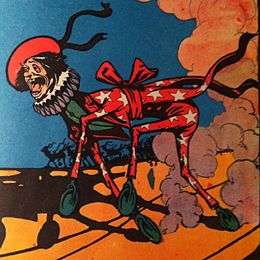
| Wikisource has original text related to this article: |
L. Frank Baum's 1907 children's book Ozma of Oz features humanoid creatures with wheels instead of hands and feet, called Wheelers.[54]
The 1968 novel The Goblin Reservation by Clifford D. Simak features an intelligent alien race that uses biological wheels.[55]
Piers Anthony's 1977 book Cluster and its sequels feature aliens called Polarians, which locomote by gripping and balancing atop a large ball. The ball is a living, though temporarily separable, portion of the Polarian's body.[56]
David Brin's Uplift Universe includes a wheeled species called the g'Kek, which are described in some detail in the 1995 novel Brightness Reef.[57] In 1996's Infinity's Shore, a g'Kek is described as looking like "a squid in a wheelchair." They suffer from arthritic axles in their old age, particularly when living in a high gravity environment.[57][58]
A 1997 novel in the Animorphs series, The Andalite Chronicles, includes an alien called a Mortron, composed of two separate entities: a yellow and black bottom half with four wheels, and a red, elongated head with razor-sharp teeth and concealed wings.[59]
The 2000 novel The Amber Spyglass, by English author Philip Pullman, features an alien race known as the Mulefa, which have diamond-shaped bodies with one leg at the front and back and one on each side. The Mulefa use large, disk-shaped seed pods as wheels. They mount the pods on bone axles on their front and back legs, while propelling themselves with their side legs. The Mulefa have a symbiotic relationship with the seed pod trees, which depend on the rolling action to crack open the pods and allow the seeds to disperse.[60]
In the 2000 novel Wheelers, by English mathematician Ian Stewart and reproductive biologist Jack Cohen, a Jovian species called "blimps" has developed the ability to biologically produce machines called "wheelers", which use wheels for locomotion.[61][62]
The children's television series Jungle Junction, which premiered in 2009, features hybrid jungle animals with wheels rather than legs; one such animal, Ellyvan, is a hybrid of an elephant and a van.[63] These animals traverse their habitat on elevated highways.[64]
See also
- Astrobiology
- Biologically inspired engineering
- Biomimicry
- Projectile use by living systems
- Robot locomotion
- Suspension (vehicle)
- Terrestrial locomotion
Notes
- ↑ Although evolutionary and developmental constraints appear to preclude the possibility of a wheel as part of an organism, they do not preclude the use of foreign objects as "wheels", either instinctively (as in the case of the dung beetles discussed above), or through intelligently directed tool use (as in human technology).
- ↑ Wheels can be considered to fall into two types: passive and driven. A passive wheel simply rolls freely over a surface, reducing friction when compared with dragging. A driven wheel is powered, and transmits energy to the surface as a means of generating forward motion.
References
- 1 2 Kruszelnicki, Karl S. (August 9, 1999). "Real Wheel Animals—Part Two". Great Moments in Science. ABC Science. Retrieved October 29, 2008.
- ↑ "Wheel". Merriam-Webster. Encyclopædia Britannica. Retrieved September 16, 2011.
- 1 2 Full, Robert; Earis, Kathleen; Wong, Mary; Caldwell, Roy (October 7, 1993). "Locomotion like a wheel?". Nature. Nature Publishing Group. 365 (6446): 495. doi:10.1038/365495a0.
- 1 2 3 4 5 6 7 Scholtz, Gerhard (2008). "Scarab beetles at the interface of wheel invention in nature and culture?". Contributions to Zoology. National Museum of Natural History Naturalis. 77 (3). ISSN 1875-9866. Retrieved January 19, 2009.
- ↑ Armstrong, Sue (July 14, 1990). "Fog, wind and heat—life in the Namib desert". New Scientist (1725). Retrieved October 11, 2008.
- ↑ Myers, Simon R.; Leigh, Irene M.; Navsaria, Harshad (September 26, 2007). "Epidermal repair results from activation of follicular and epidermal progenitor keratinocytes mediated by a growth factor cascade". Wound Repair and Regeneration. 15 (5): 693–701. doi:10.1111/j.1524-475X.2007.00297.x. PMID 17971015.
- ↑ Anderson, K.I.; Wang, Y.L.; Small, J.V. (September 1996). "Coordination of protrusion and translocation of the keratocyte involves rolling of the cell body". J. Cell Biol. 134 (5): 1209–18. doi:10.1083/jcb.134.5.1209. PMC 2120980
 . PMID 8794862.
. PMID 8794862. - ↑ Pechenik, Jan A. (2005). Biology of the invertebrates. Boston: McGraw-Hill, Higher Education. p. 178. ISBN 0-07-234899-2.
- ↑ Owen, Jennifer (1980). "Filter-feeding". Feeding Strategy. University of Chicago Press. p. 89. ISBN 0226641864. Retrieved 1 June 2015.
- ↑ Kristensen, J. Hilleberg (August 1972). "Structure and Function of Crystalline Styles of Bivalves" (PDF). Ophelia. 10: 91–108. doi:10.1080/00785326.1972.10430106. Retrieved 1 June 2015.
- 1 2 Oster, George; Wang, Hongyun (March 2003). "Rotary protein motors". Trends Cell Biol. 13 (3): 114–21. doi:10.1016/S0962-8924(03)00004-7. PMID 12628343.
- ↑ Feniouk, Boris A. "ATP Synthase FAQ". ATP Synthase—A Splendid Molecular Machine. Retrieved August 16, 2011.
- ↑ Crofts, Anthony (1996). "Lecture 10: ATP Synthase". Biophysics 354: Biological Energy Conversion. University of Illinois at Urbana-Champaign. Retrieved August 16, 2011.
- ↑ Falk, Gunnar; Walker, John E. (1988). "DNA sequence of a gene cluster coding for subunits of the F0 membrane sector of ATP synthase in Rhodospirillum rubrum. Support for modular evolution of the F1 and F0 sectors" (PDF). Biochemical Journal. 254 (1): 109–122. PMC 1135046
 . PMID 2902844.
. PMID 2902844. - 1 2 3 4 5 6 7 8 9 10 LaBarbera, Michael (March 1983). "Why the Wheels Won't Go". The American Naturalist. The University of Chicago Press. 121 (3): 395–408. doi:10.1086/284068. JSTOR 2461157.
- 1 2 3 4 5 6 7 8 9 Diamond, Jared (April 14, 1983). "The biology of the wheel". Nature. Macmillian Journals Ltd. 302 (5909): 572–573. doi:10.1038/302572a0. PMID 6835391.
- ↑ Gebremichael, Yeshitila; Ayton, Gary S.; Voth, Gregory A. (November 2006). "Mesoscopic Modeling of Bacterial Flagellar Microhydrodynamics". Biophys. J. 91 (10): 3640–52. doi:10.1529/biophysj.106.091314. PMC 1630491
 . PMID 16935949.
. PMID 16935949. - ↑ Goldsworthy, Andrew (2005). "Pre-inventing the Wheel". In O'Hare, Mick; New Scientist. Does Anything Eat Wasps? And 101 Other Questions. London: Profile Books. p. 182. ISBN 1 86197 835 9. OCLC 61757621. Retrieved December 4, 2012 – via Google Books.
- ↑ Atsumi, Tatsuo; McCartert, Linda; Imae, Yasuo (1992). "Polar and lateral flagellar motors of marine Vibrio are driven by different ion-motive forces". Nature. 355 (6356): 182–184. doi:10.1038/355182a0. PMID 1309599.
- ↑ Chwang, A.T.; Wu, T.Y.; Winet, H. (November 1972). "Locomotion of Spirilla". Biophysical Journal. Cell Press. 12 (11): 1549–61. Bibcode:1972BpJ....12.1549C. doi:10.1016/S0006-3495(72)86181-2. ISSN 1542-0086. PMC 1484193
 . PMID 4642227.
. PMID 4642227. - ↑ Ng, S.Y.; Chaban, B.; Jarrell, K.F. (2006). "Archaeal flagella, bacterial flagella and type IV pili: a comparison of genes and posttranslational modifications". J. Mol. Microbiol. Biotechnol. 11 (3–5): 167–91. doi:10.1159/000094053. PMID 16983194.
- ↑ Mitchell, David R. (2007). "The evolution of eukaryotic cilia and flagella as motile and sensory organelles". Adv. Exp. Med. Biol. Advances in Experimental Medicine and Biology. 607: 130–40. doi:10.1007/978-0-387-74021-8_11. ISBN 978-0-387-74020-1. PMC 3322410
 . PMID 17977465.
. PMID 17977465. - 1 2 3 4 5 Dawkins, Richard (November 24, 1996). "Why don't animals have wheels?". Sunday Times. Archived from the original on February 21, 2007. Retrieved October 29, 2008.
- ↑ Kimura, M. (1991). "The neutral theory of molecular evolution: a review of recent evidence". Jpn. J. Genet. 66 (4): 367–86. doi:10.1266/jjg.66.367. PMID 1954033.
- ↑ Otto, S.P.; Whitlock, M.C. (1997). "The Probability of Fixation in Populations of Changing Size". Genetics. 146 (2): 723–33. PMC 1208011
 . PMID 9178020.
. PMID 9178020. - 1 2 3 Gould, Stephen Jay (1981). "Kingdoms Without Wheels". Natural History. New York. 90 (3): 42–48. ISSN 0028-0712.
- ↑ Matzke, Nicholas J. (2003). "Evolution in (Brownian) space: a model for the origin of the bacterial flagellum". TalkOrigins.org. Retrieved June 2, 2008.
- ↑ Matzke, Nicholas J. (September 7, 2006). "Flagellum evolution in Nature Reviews Microbiology". The Panda's Thumb. Retrieved June 2, 2008.
- ↑ Pallen, Mark J.; Matzke, Nicholas J. (October 2006). "From The Origin of Species to the origin of bacterial flagella". Nat. Rev. Microbiol. 4 (10): 784–90. doi:10.1038/nrmicro1493. PMID 16953248.
- ↑ Gould, Steven Jay; Vrba, E.S. (1982). "Exaptation; a missing term in the science of form". Paleobiology. 8 (1): 4–15.
- ↑ Holliday, Robin (June 2003). "Creationism and the wheel". BioEssays. Wiley Periodicals. 25 (6): 620–621. doi:10.1002/bies.10280. ISSN 1521-1878. PMID 12766952.
- ↑ Fish, Frank E.; Lauder, George V.; Mittal, Rajat; Techet, Alexandra H.; Triantafyllou, Michael S.; Walker, Jeffery A.; Webb, Paul W. (June 8, 2003). "Conceptual Design for the Construction of a Biorobotic AUV Based on Biological Hydrodynamics" (PDF). George Washington University. Retrieved January 28, 2009.
- ↑ Full, Robert J. (February 2002). Robert Full on Engineering and Evolution (Conference presentation video). TED Conferences. Retrieved April 15, 2011.
- ↑ Adams, Cecil (May 15, 1998). "Why has no animal species ever evolved wheels?". The Straight Dope. Chicago Reader. Retrieved April 15, 2011.
- ↑ Lienhard, John H. "A Man with Wheels?". The Engines of Our Ingenuity. Episode 406. No. 406: A Man with Wheels?. Houston: University of Houston. National Public Radio. KUHF-FM. Retrieved December 5, 2014.
- ↑ "Tech Today: Walking Forest Machine". Space.com. Archived from the original on March 10, 2006. Retrieved September 25, 2009.
- ↑ Wong, Jo Yung (2008). Theory of Ground Vehicles. John Wiley and Sons. ISBN 978-0-470-17038-0 – via Google Books.
- ↑ Balasubramanian, Ravi (May 2004). "Legless Locomotion: Concept and Analysis". Carnegie Mellon University: 1. CiteSeerX 10.1.1.118.7949
 .
. - ↑ "Center of Gravity and Roll-Over Angle". Jeepaholics Anonymous. Retrieved August 16, 2011.
- ↑ Johnson, Raymond P. (June 1993). "Unstable Vehicles—Unsafe at Any Speed". Raymond Paul Johnson, a Law Corporation. Retrieved August 16, 2011.
- ↑ Pruett, Chris (November 2010). "The Anthropology of Fear: Learning About Japan Through Horror Games". Interface on the Internet. Pacific University, Oregon: Berglund Center for Internet Studies. 10 (9). Retrieved April 16, 2011.
- ↑ de Plancy, Jacques-Albin-Simon Collin (1825). Dictionnaire infernal (in French). P. Mongie aîné. p. 478. Retrieved 12 September 2016.
- ↑ de Plancy, Jacques-Albin-Simon Collin (1863). Henri Plon, ed. Dictionnaire infernal (in French). p. 123. Retrieved 12 September 2016.
- ↑ Brown, Fredric (1944). Arena. Astounding Stories. ISBN 1-159-66412-9. Archived from the original on April 14, 2009.
- ↑ Arena title listing at the Internet Speculative Fiction Database
- ↑ Escher, Maurits Cornelis (2001). M.C. Escher, the graphic work. Germany: Taschen. pp. 14, 65. ISBN 3-8228-5864-1.
- ↑ "Uncle Scrooge: Land Beneath the Ground!". Inducks Database. COA. Retrieved July 15, 2012.
- ↑ "Terries and Fermies". Inducks Database. COA. Retrieved July 15, 2012.
- ↑ Grøsfjeld, Sigvald, Jr. "Chapter VII (1952-1959): The 1950's". The Lives and Times in Duckburg. Retrieved July 15, 2012.
- ↑ Martin, George R.R. (1986). Tuf Voyaging. Baen Books. ISBN 0-671-55985-0. Retrieved December 5, 2014 – via Le Cercle Fantastique.
- ↑ Sonic Team (June 23, 1991). Sonic the Hedgehog. Sega.
- ↑ Thomas, Lucas M. (January 26, 2007). "Sonic the Hedgehog VC Review". IGN. IGN Entertainment. Retrieved April 16, 2011.
- ↑ Slonczewski, Joan (1998). Microbe. The Children Star. Tor Science Fiction. ISBN 0-312-86716-6.
- ↑ Baum, Lyman Frank (1907). Ozma of Oz. Oz. 3. John Rea Neill (illustrator). Chicago: The Reilly & Britton Co. pp. 44–45. ISBN 978-1-173-24727-0 – via Google Books.
- ↑ Simak, Clifford D. (1968). The Goblin Reservation (PDF). New York: G. P. Putnam's Sons. pp. 5, 42. ISBN 978-0-88184-897-7.
- ↑ Anthony, Piers (October 1977). Cluster. Avon Books. pp. 18–20,143. ISBN 978-1-61756-013-2 – via Google Books.
- 1 2 Brin, David (1995). Brightness Reef. Uplift trilogy. 1. Random House. ISBN 978-0-553-57330-5 – via Google Books.
- ↑ Brin, David (1996). Infinity's Shore. Uplift trilogy. 2. Easton Press. ISBN 978-1-85723-565-4 – via Google Books.
- ↑ Applegate, K. A. (1997). The Andalite Chronicles. Animorphs. Scholastic Press. ISBN 978-0-590-10971-0.
- ↑ Pullman, Philip (2000). The Amber Spyglass. His Dark Materials. 3. Alfred A. Knopf. ISBN 978-0-375-84673-1 – via Google Books.
- ↑ Stewart, Ian; Cohen, Jack (2000). Wheelers. Warner Books. ISBN 978-0-446-52560-2 – via Google Books.
- ↑ "Wheelers". Kirkus Reviews. September 15, 2000. Retrieved August 16, 2011.
- ↑ Jungle Junction (2009– ) at the Internet Movie Database
- ↑ "The Treasure of Jungle Junction". Jungle Junction. Series 1. Episode 4a. October 3, 2009. Disney Channel. Retrieved December 4, 2014.
External links
- "Rolling Salamanders & Caterpillars" on YouTube, from BBC's Weird Nature
- "Animal Olympians: Gymnastics" on YouTube, featuring a rolling golden wheel spider
